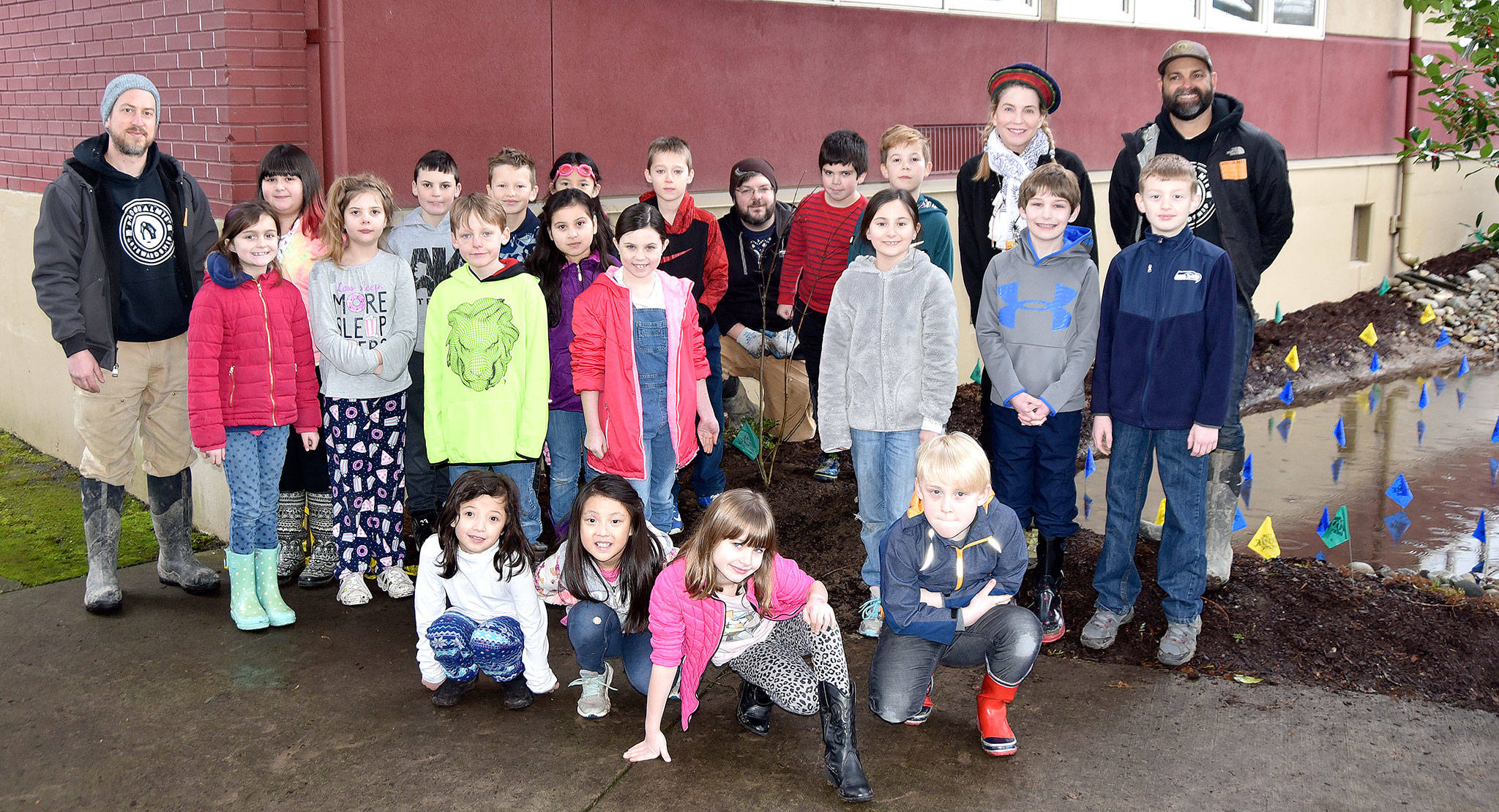Between the excitement of planting — and naming — the new residents of the Carnation Elementary School rain garden and discovering the latest activity of a visiting woodpecker, the school’s third grade students had their hands and minds full last Friday morning.
And staff from Stewardship Partners kept on filling both, giving each student some hands-on time with a shovel and dirt, and loading their brains with facts about native plants and the erosion rain gardens are designed to prevent.
Wing, a past King County Earth Hero and longtime classroom advocate of thinking green was gratified to be a part of the project. Like her students, she watched, absorbed as Stewardship Partners staff described the rain garden and the function of the plants.
“It’s all about sustainability, and the students seeing themselves as citizen scientists,” said Wing.
All three third grade classes were involved in the rain garden project, sponsored by Stewardship Partners and the Snoqualmie Tribe. Together, they planted 225 square-foot rain garden that could absorb the runoff from the schools 6,500 square-foot roof, with lots of lessons along the way.
“What does ground cover do?” asked Chris LaPointe, the project coordinator for Carnation Elementary’s rain garden. He was showing the class a Kinnikinnick shrub, one of the ground cover types to be planted in the rain garden.
“It covers the ground,” said one boy, going for the obvious answer.
“It’s invasive!” declared another. Sometimes, but not in the case of this plant, LaPointe corrected him.
The important thing about groundcover, he told the students, was how it helped to prevent erosion. In the case of the Carnation Elementary rain garden, the ground cover will work to hold the rainwater from the school roof in place until the plants and soil can absorb it more slowly, instead of letting the gush of stormwater flow straight into the storm drains and then into the nearby Snoqualmie River.
“It’ll pool up a little bit, and then all of the plants in the rain garden will help absorb all of the pollutants,” LaPointe said. “That’s their function, to sequester carbon.”
This tiny rain garden will, when complete, treat an estimated 150,000 gallons of rainwater annually, he added.
Teacher Elizabeth Wing asked her class as they finished planting one of the largest elements of the garden, a deciduous vine maple, “Can you envision diagramming this plan in your science notebooks?”
Some could, but most were more interested in high-fiving each other with their dirt-covered hands, or glued to Geoff Bough’s every action as he showed them how to check the depth of the hole for a plant, and how to loosen the roots.
“All of these plants that we’re installing… (they’re) all native plants,” said LaPointe. He had some 150 plants, both water-loving and more tolerant of this area’s dry summer conditions, ready to go into three zones of the tiny space, although he wasn’t sure they’d all fit. He also was already hoping that they would soon be back for a future planting of some native plants, such as Western Trillium, that the nurseries couldn’t get in time for this one.
“The Snoqualmie Tribe helped us choose plants that were culturally significant,” he added, and most of the plants came from Snoqualmie Valley nurseries.
The rain garden itself is significant as a symbol, too, since it’s located in the heart of a farming valley, LaPointe said.
“One of the connections that we’re making is, oftentimes, agricultural areas have taken out all the trees and shrubs, and what that does essentially is takes out all those filtering processes,” of the plants’ root systems. Rain gardens help restore those processes on a smaller scale and in pockets.
The garden also represents the balance of competing demands in the small space. A few existing plants had to be taken out of the space to make room for the native types, explained Kirby Johnson, also on the Stewardship Partners restoration crew. At least one invasive plant got to stay, though.
“Holly is, kind of, technically invasive,” he explained, “but the birds love it,” and we love the birds, so the holly stayed while a less viable juniper and a dying cherry tree both were removed.
As part of the Stewardship Partners work with Carnation Elementary School, students will also be taken on a field trip to see another of the organization’s main efforts, habitat buffers along the riparian zones of rivers.
To celebrate the completed garden, Stewardship Partners is planning a public ribbon cutting and work party, starting at 10 a.m. Saturday, Feb. 3 with the ribbon cutting.
And after that, future third graders at the school will help to maintain the garden.
“Not every class is going to be able to install a rain garden,” said LaPointe, “but they’re all going to be able to care for it.”
Learn more about Stewardship Partners at http://www.stewardshippartners.org.



